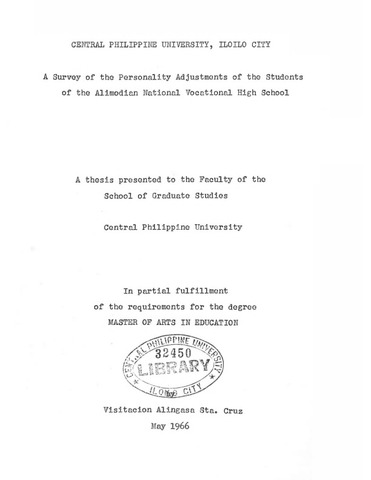| dc.contributor.adviser | Ruiz, Macario B. | |
| dc.contributor.author | Sta. Cruz, Visitacion Alingasa | |
| dc.date.accessioned | 2021-12-03T06:08:02Z | |
| dc.date.available | 2021-12-03T06:08:02Z | |
| dc.date.issued | 1966 | |
| dc.identifier.citation | Sta. Cruz, V. A. (1966). A survey of the personality adjustments of the students of the Alimodian National Vocational High School (Unpublished Master’s thesis). Central Philippine University, Jaro, Iloilo City. | en_US |
| dc.identifier.uri | https://hdl.handle.net/20.500.12852/1753 | |
| dc.description | Abstract only | en_US |
| dc.description.abstract | This study was undertaken to assess the personality adjustments of the students of the Alimodian National Vocational High School for the school year 1963-1964. It primarily aimed to group the students according to the major personality types, such as dominance-submission, extroversion-introversion, emotional stability, emotional maturity, and social maturity. Secondarily, it aimed to determine the degree of relationships between these personality type groupings and order of birth, socio-economic status, intelligence levels, age-groups, and curriculum year. In the absence of a suitable standardized personality inventory for purposes of classification, it was necessary to prepare one. The investigator reviewed several personality inventories related to the problem at hand in order to gather appropriate items for the inventory. Another major source of items for the inventory was the contributions of teachers who are interviewed. The collected items were then validated and those with poor discriminating power were eliminated. The reliability of the inventory was determined and finally a total of 120 items were prepared. The inventory was administered to all the students from the first year to the fourth year. The socio-economic status of the home of 130 sample students was determined through the use of the form for the socio-economic rating for homes. To facilitate the statistical treatment and classification of the data, the findings wore recorded on punched data sheets.
The findings revealed that more eldest children were submissive. However, more submissive students were among the high and upper middle socio-economic levels. More emotionally mature students were found among the high, upper middle and middle levels; and more emotionally mature and socially mature students were found among the high and upper middle levels. More students with very high, high, and above average intelligence were found to be extroverted; while students with below average intelligence equally grouped themselves on the extroversion-introversion inventory. More students were found to be emotionally stable. On the emotional maturity inventory, more students with the very high, high, and above average intelligence levels were found to be emotionally mature; those with average intelligence were found to be emotionally immature. The findings also showed that more submissive students were among the second-year group, more introverted students among the third year, and more emotionally stable and mature students among the fourth year group, and more socially mature students among the third year group. The data revealed no indication of group trends among the students with reference to their age levels. More students were found to be submissive, introverted, emotionally mature, except that the 11-14 and 15-18 age groups were found to be more emotionally stable than unstable. As regards personality groups by sex, the findings showed that more girls were introverted and socially mature while more boys were found to be emotionally mature.
Correlations in this study showed that dominancesubmission and extroverted-introverted tendencies of students were not associated with order of birth, socio-economic status, intelligence, age-groups, or curriculum year; that the development of emotional stability was not related to order of birth, socio-economic status, or age-groups; that the development of emotional maturity was, to a slight degree, related to socio-economic status, intelligence, age-groups, and curriculum year; and that emotional maturity was not associated with order of birth in the family. The data in this study also showed that educational attainment of students was considerably related to their development in social maturity; that intelligence was slightly related to social maturity, and that order of birth, age-group, socio-economic status were related to a slight degree to the development of social maturity. | en_US |
| dc.format.extent | 150 leaves | en_US |
| dc.language.iso | en | en_US |
| dc.subject.ddc | GSL Theses 378.242 Sa59 | en_US |
| dc.subject.lcsh | Personality tests | en_US |
| dc.subject.lcsh | Personality | en_US |
| dc.subject.lcsh | Personality assessment | en_US |
| dc.subject.lcsh | High school students | en_US |
| dc.title | A survey of the personality adjustments of the students of the Alimodian National Vocational High School | en_US |
| dc.type | Thesis | en_US |
| dc.description.bibliographicalreferences | Includes bibliographical references | en_US |
| dc.contributor.chair | Ruiz, Macario B. | |
| dc.contributor.committeemember | Nelson, Linnea A. | |
| dc.contributor.committeemember | Porter, Josefina Y. | |
| dc.contributor.committeemember | Griño, Eliza U. | |
| dc.contributor.committeemember | Alba, Leda G. | |
| dc.contributor.committeemember | Revicencio, Patria J. | |
| dc.contributor.committeemember | Ruiz, Josefina J. | |
| dc.contributor.committeemember | Ortigoza, Emma O. | |
| dc.contributor.department | School of Graduate Studies | en_US |
| dc.description.degree | Master of Arts in Education | en_US |
| local.subject | Alimodian National High School | en_US |


